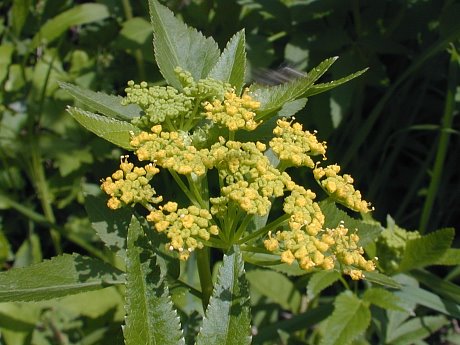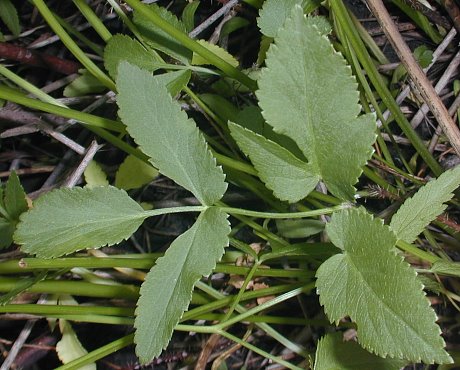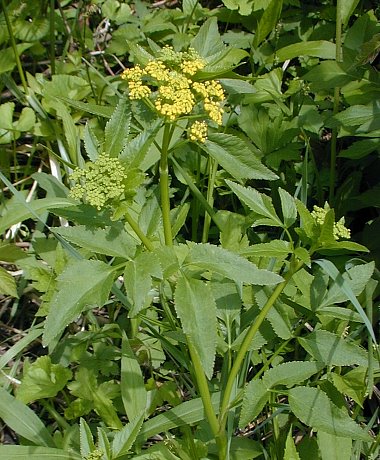Description: This herbaceous perennial plant is up to 2½' tall, forming occasional lateral stems. These stems are light green, hairless, and rather shiny. The shiny compound leaves are medium green, hairless, and odd-pinnate with 3 or 5 leaflets. The lower compound leaves have long petioles, which become shorter as the leaves alternate upward along the stems. The variable leaflets are up to 3" long and 2" across; they are lanceolate, ovate, cordate, or broadly oblong in shape, although the larger leaflets sometimes have 1-2 cleft lobes. Leaflet margins are serrated.

Flat to slightly rounded compound umbels of yellow flowers occur at the ends of the upper stems. Each compound umbel is about 2-3" across, and consists of about 12 umbellets. There are about 21 flowers in each umbellet; the central flower of each umbellet is sessile (or nearly so) during the blooming period. Each flower is about 1/8" (3 mm.) across; it has 5 incurved yellow petals, an insignificant calyx, a pistil, and 5 stamens. The blooming period occurs from late spring to early summer, and lasts about 1 month. There is no floral scent. The seeds are oblong and flattened, but not winged, with several lighter-colored longitudinal ridges. The root system consists of a dense cluster of coarse fibrous roots.

Cultivation:
The
preference is full to partial sun, although light shade under trees is
tolerated. The soil should be moist and loamy, and can contain some
rocky material. Foliar disease rarely occurs. The seeds can be
difficult to germinate, otherwise this plant is easy to grow and
maintain.
Range & Habitat:
The native Golden Alexanders is occasional to locally common in most
areas of
Illinois, except for some southern and western counties, where it is
uncommon or absent (see Distribution
Map).
Habitats include moist black soil prairies, openings in moist to mesic
woodlands, areas along woodland paths, savannas, thickets, limestone
glades, thinly wooded bluffs, powerline clearances in wooded
areas, and abandoned fields. Golden Alexanders occurs in both degraded
and higher quality habitats. It adapts readily to habitat restorations.

Faunal Associations: The flowers are attractive to many kinds of insects seeking pollen or nectar, especially short-tongued bees, wasps, flies, and beetles. Among the short-tongued bees are such visitors as Green Metallic bees, Masked bees, and Andrenid bees (including the oligolege, Andrena ziziae). Wasp visitors include Eumenine wasps, spider wasps, Ichneumonid wasps, and Crabronine wasps. Such long-tongued bees as bumblebees, cuckoo bees (Nomada spp.) also visit the flowers, as do some small butterflies and true bugs. Notwithstanding all of these visitors, this plant is capable of self-pollination. Caterpillars of the butterflies Papilio polyxenes asterius (Black Swallowtail) and Papilio joanae (Ozark Swallowtail) feed on the leaves and flowers, while caterpillars of Papaipema rigida (Rigid Sunflower Borer Moth) bore through the stems. Two aphids, Aphis saniculae and Aphis thaspii, suck plant juices from Golden Alexanders and similar species in the Carrot family.

Photographic
Location:
The photographs were taken at Busey Woods in Urbana, Illinois.
Comments:
Golden Alexanders should not be confused with Pastinaca sativa
(Wild Parsnip), which is a weedy Eurasian biennial. The latter is
taller, blooms later, and has more leaflets in each compound leaf. It
can be particularly difficult to distinguish Golden Alexanders from Thaspium
trifoliatum aureum (Yellow
Meadow Parsnip), which is another native perennial plant. For the
latter plant, the central flower of each umbellet has a short
pedicel, the achenes are winged, and its basal leaves are
simple,
rather than trifoliate. Otherwise, these two species share nearly the
same characteristics. Golden Alexanders is an excellent addition to a
wildflower garden because it provides accessible nectar to many
beneficial insects with short mouthparts during the spring and early
summer when such flowers are relatively uncommon.